 W
WThe killing of animals is animal euthanasia, animal sacrifice, animal slaughter, hunting, blood sports, or roadkill.
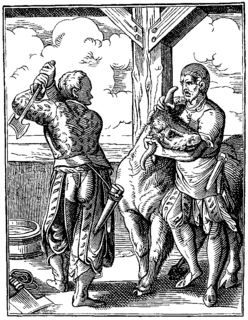 W
WAnimal slaughter is the killing of animals, usually referring to killing domestic livestock. It is estimated that each year 77 billion land animals are slaughtered for food. In general, the animals would be killed for food; however, they might also be slaughtered for other reasons such as being diseased and unsuitable for consumption. The slaughter involves some initial cutting, opening the major body cavities to remove the entrails and offal but usually leaving the carcass in one piece. Such dressing can be done by hunters in the field or in a slaughterhouse. Later, the carcass is usually butchered into smaller cuts.
 W
WAnimal attacks are violent, often fatal attacks caused by animals against humans, one of the most common being bites. Bites are wounds caused as a result of an animal or human attack. These attacks cause of human injuries and fatalities worldwide. According to the 2012 U.S. Pet Ownership & Demographics Sourcebook, 56% of United States citizens owned a pet. In the United States in 1994, approximately 4.7 million people were bitten by dogs. One factor that has notably affected the amount of these statistical numbers has been the increase in the animal population. This has increased the risk of transmission of zoonotic diseases and other bacteria that can affect human health. The frequency of animal attacks varies with geographical location, as well as hormonal secretion. Gonad glands found on the anterior side of the pituitary gland secrete androgens and estrogens hormones. Animals with high levels of these hormones tend to be more aggressive, which leads to a higher frequency of attacks not only to humans but among themselves. In the United States, a person is more likely to be killed by a domesticated dog than they are to die from being hit by lightning according to the National Safety Council.
 W
WBadger culling in the United Kingdom is permitted under licence, within a set area and timescale, as a way to reduce badger numbers in the hope of controlling the spread of bovine tuberculosis (bTB).
 W
WBullfighting is a physical contest that involves a bullfighter and animals attempting to subdue, immobilize, or kill a bull, usually according to a set of rules, guidelines, or cultural expectations.
 W
WA captive bolt pistol or gun is a device used for stunning animals prior to slaughter.
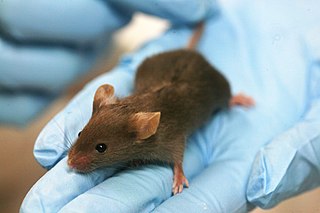 W
WCervical dislocation is a common method of animal euthanasia. It refers to a technique used in physical euthanasia of small animals by applying pressure to the neck and dislocating the spinal column from the skull or brain. The aim is to quickly separate the spinal cord from the brain so as to provide the animal with a fast and painless death; however, research on this method has shown it does not consistently concuss the brain and may not cause instantaneous insensibility.
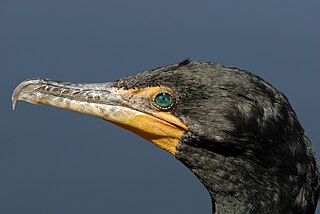 W
WCormorant culling is the intentional killing of cormorants by humans for the purposes of wildlife management. It has been practiced for centuries, with supporters of culling generally arising from the angling community. Culling techniques may involve the killing of birds, the destruction of eggs, or both. Historically, culls have occurred to protect the interests of recreational and commercial fishermen who perceive the animals to be competing with them for their intended catch or for the prey of their intended catch. Since the 1960s, the growing aquaculture industry has undertaken cormorant culls to protect its farmed fish and crustacean stocks. Opponents of cormorant culling include conservation groups such as the National Audubon Society, Cormorant Defenders International and Sea Shepherd.
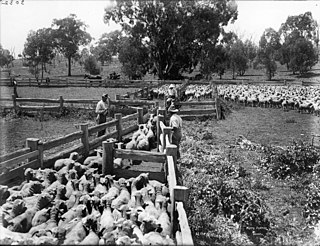 W
WIn biology, culling is the process of segregating organisms from a group according to desired or undesired characteristics. In animal breeding, it is the process of removing or segregating animals from a breeding stock based on specific trait. This is done to exaggerate desirable characteristics, or to remove undesirable characteristics by altering the genetic diversity of the population. For livestock and wildlife, culling often refers to the act of killing removed animals based on their individual characteristics, such as their sex or species membership, or as a means of preventing infectious disease transmission.
 W
WAnimal dysthanasia refers to the practice of prolonging the life of animals that are seriously or even terminally ill and that are potentially experiencing suffering. Animal dysthanasia is a recent concept, emerging from changes in the social perception of animals and from advances in veterinary care.
 W
WThe Humane Slaughter Association (HSA) supports research, training, and development to improve the welfare of livestock during transport and slaughter. It provides technical information about handling and slaughter on its website, training for farmer staff and vets, advice to governments and industry, and funding of science and technology to make slaughter more humane. HSA is the sister charity to Universities Federation for Animal Welfare.
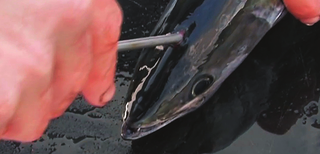 W
WIkejime (活け締め) or Ikijime (活き締め) is a humane method of killing fish to maintain the quality of its meat. The technique originated in Japan, but is now in widespread use. It involves the insertion of a spike quickly and directly into the hindbrain, usually located slightly behind and above the eye, thereby causing immediate brain death. When spiked correctly, the fish fins flare and the fish relaxes, immediately ceasing all motion. Destroying the brain and the spinal cord of the fish will prevent reflex action from happening; such muscle movements would otherwise consume adenosine triphosphate (ATP) in the muscle, and as a result produce lactic acid and ammonia, making the fish sour, soggy and less tasteful. Furthermore, the blood contained in the fish flesh retracts to the gut cavity, which produces a better coloured and flavoured fillet, and prolongs shelf life. This method is considered to be the fastest and most humane method of killing fish. Ikejime-killed fish is sought-after by restaurants as it also allows the fish to develop more umami when aged.
 W
WInsect euthanasia is the process of killing insects "in a way that minimizes or eliminates pain and distress." It may apply to animals in the laboratory, schools, as pets, as food, or otherwise.
 W
WA killing jar is a device used by entomologists to kill captured insects quickly and with minimum damage. The jar, typically glass, must be hermetically sealable and one design has a thin layer of hardened plaster of Paris on the bottom to absorb the killing agent. The killing agent will then slowly evaporate, allowing the jar to be used many times before needing to refresh the jar. The absorbent plaster of Paris layer also helps prevent the agent sticking to and damaging insects. Crumpled paper tissue is also placed in the jar for the same reason. A second method utilises a wad of cotton or other absorbent material placed in the bottom of the jar. Liquid killing agent is then added until the absorbent material is nearly saturated. A piece of stiff paper or cardboard cut to fit the inside of the jar tightly is then pressed in.
 W
WPig slaughter is the work of slaughtering domestic pigs which is both a common economic activity as well as a traditional feast in some European and Asian countries.
 W
WRattlesnake round-ups , also known as rattlesnake rodeos, are annual events common in the rural Midwest and Southern United States, where the primary attractions are captured wild rattlesnakes which are sold, displayed, killed for food or animal products or released back into the wild. Rattlesnake round-ups originated in the first half of the 20th century for adventure and excitement, as well as to achieve local extirpation of perceived pest species. Typically a round-up will also include trade stalls, food, rides, and other features associated with fairs, as well as snake shows that purport to provide information on rattlesnake biology, identification, and safety, but actually perpetuate misinformation and myths about snakes while demonstrating unsafe handling techniques. To date, round-ups where snakes are killed take place in Alabama, Georgia, Oklahoma, and Texas, with largest events in Texas and Oklahoma. Many round-ups are no longer slaughtering snakes, but have transitioned to educational festivals celebrating rattlesnakes and other wildlife. All round-ups in Pennsylvania return snakes to the wild and two former round-ups in Georgia and Florida use captive animals for their festivals. The largest rattlesnake round-up in the United States is held in Sweetwater, Texas. Held annually in mid-March since 1958, the event currently attracts approximately 30,000 visitors per year and in 2006 each annual round-Up was said to result in the capture of 1% of the state's rattlesnake population, but there are no data or studies to support this claim.
 W
WShooting, shoveling, and shutting up, also known as the 3-S treatment, refers to a method for dealing with unwanted or unwelcome animals primarily in rural areas. There have been reports of the frequently illegal triple-step procedure being used to dispatch mischievous pets, endangered species, and even sick livestock. Individuals often engage in this practice as a means to protect property or pets from predatory species that are protected by law, especially if other measures to protect their animals are unfeasible. For instance, eagles, a protected species, have been known to occasionally attack and kill young livestock on ranches. Similarly, there have been multiple incidents where hawks have attacked and killed small farm poultry and pets. Farmers and pet owners caught killing such animals have been prosecuted, regardless of their reasons for doing so.
 W
WSlaughtered Ox, also known as Flayed Ox, Side of Beef, or Carcass of Beef, is a 1655 oil on beech panel still life painting by Rembrandt. It has been in the collection of the Louvre in Paris since 1857. A similar painting is in Kelvingrove Art Gallery and Museum, Glasgow, possibly by Rembrandt himself but probably by one of his pupils, perhaps Fabritius. Other similar paintings by Rembrandt or more likely his circle are held by museums in Budapest and Philadelphia.
 W
WStunning is the process of rendering animals immobile or unconscious, with or without killing the animal, when or immediately prior to slaughtering them for food.